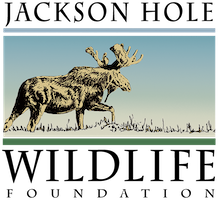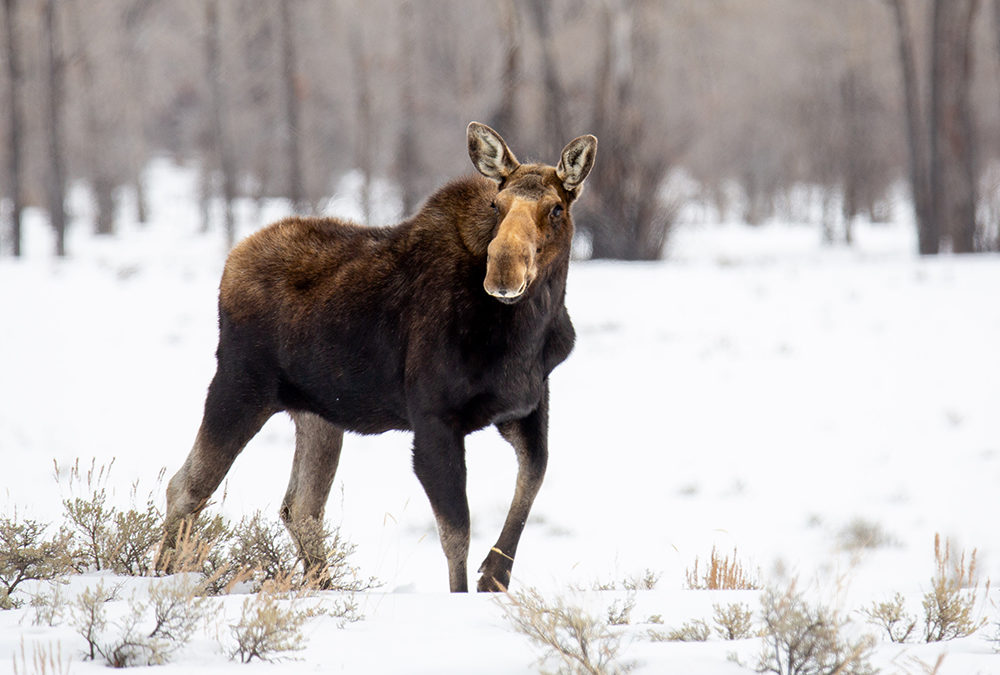
by jhwildlife | Mar 19, 2021 | Blog
By Frances Clark | Nature Mapping Ambassador
All 2021 Moose Day Volunteers,
Thank you for your extraordinary participation in Moose Day 2021. At this time, we have preliminary totals of 106 moose and 109 volunteers who spent 300 hours scouting! The majority of you drove (163 hrs), others skied (74 hrs), a few snowmobiled (33.5 hrs), many walked (25 hrs), and one group snowshoed (4 hrs).This is impressive! Unfortunately, as often happens on Moose Day, only half the teams saw moose (18 out of 34). This is not a reflection on your effort—you tried hard! Moose appeared most frequently along the Gros Ventre River as far east as the Darwin Ranch (14), to along the stretch around Kelly to the rotary (19). Others were seen in much less wild terrain, such as around golf courses at Teton Golf and Tennis and Teton Pines (around 20). Some were resting and feeding in neighborhoods around Wilson, Tribal Trails, and Crescent H subdivisions. Areas of deep snow in the park, downtown Jackson, the forested slopes along Fish and Fall Creek Roads had none this year. Even the Buffalo Valley, a former hotspot, had only 4 moose.
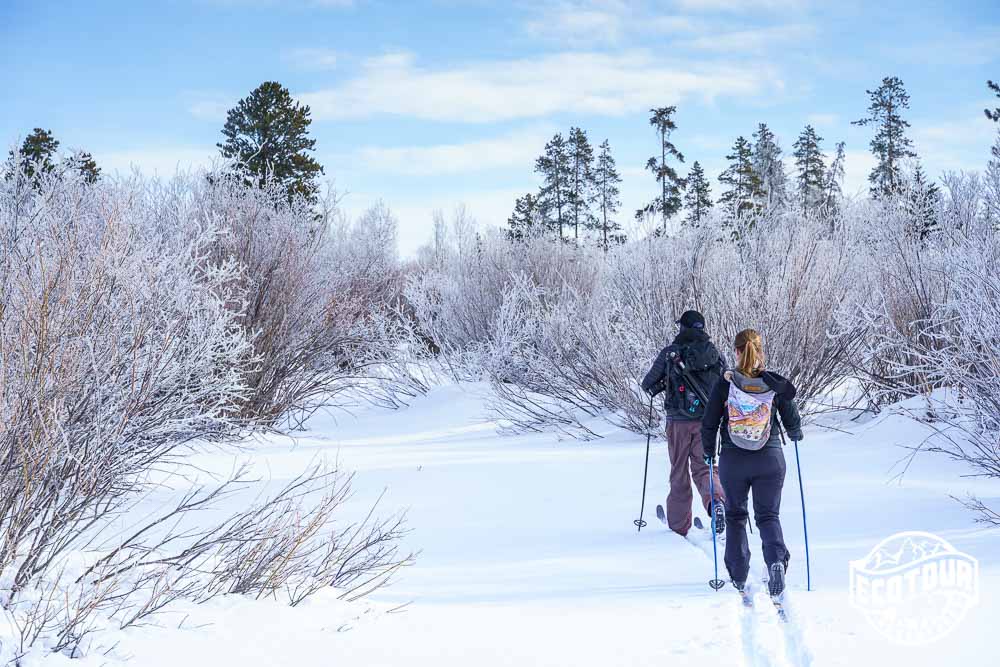
Photo: Josh Metten, Ecotour Adventures
Searching for moose had its challenges. Several reported steep and high snowbanks along roads. “Berms were high so though we tried to cover the area, one never knows as it only takes a small something to hide the animals when they are lying down.” Grace Barca and her granddaughter Elly spent the morning combing the area along Fall Creek Road and up into Indian Paintbrush. “The residents said the snow was too deep on the hill.” So they looked on the flats … “We crossed three streams: Fish and Fall Creeks and the Snake and expected something in the lowlands.” Still no moose. Moose were few around Trail Creek likely because of the cross-country ski races. Notably, for only the second year, we had a team in Alta who spotted 2 moose after much driving and walking.
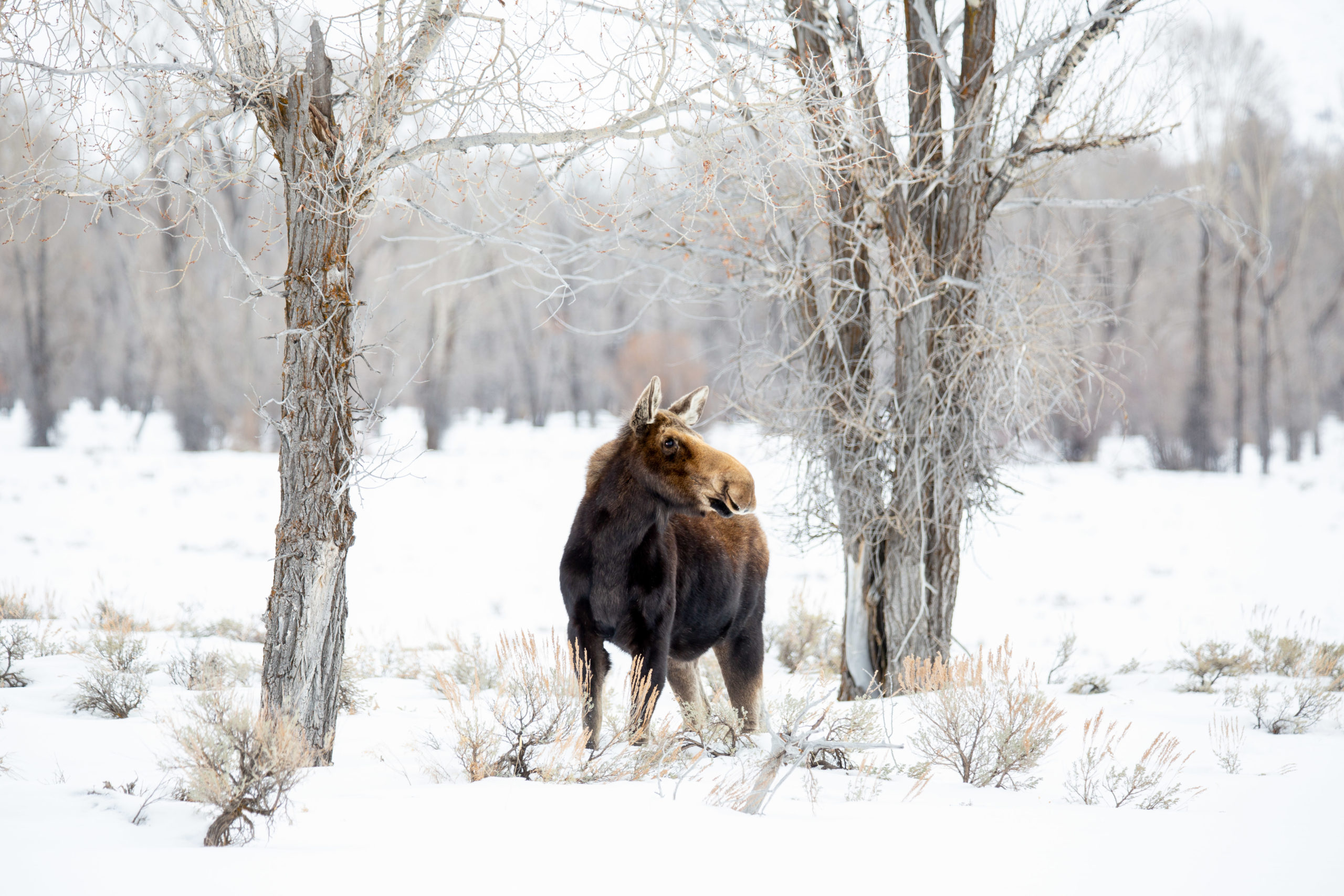
Photo: Jenny McCarthy
Jason Wilmot, biologist with the US Forest Service, led the most adventurous team on two snowmobiles east out the Gros Ventre to the Darwin Ranch. He texted: “We saw 14 moose up the Gros …. Only one dead snowmobile! Bummer. All safe though!…Beautiful up there!”…“On the hunt for a new snowmobile.” His teammate Lesley Williams, who waited two hours while the one snowmobile finished the search, was delighted to have the time alone in the solitude of wilderness. We appreciate the USFS folks for taking their days off to go search for moose.
While many people did not see moose, they did see other wildlife. The team in the north end of the park around the Jackson Lake Dam had a special treat: Kent Clements and his wife saw otter tracks around Willow Flats, and Eric Carr actually saw an otter “catch the biggest sucker fish I’ve ever seen. Huge!” Matt Fagan reported, “No moose, no traces, but we did get to watch a family of four otters moving through Willow Flats up and over dam wall…body sledding, each taking their own line down the back side. Very fun to watch. Their movements were like inchworms: doubling up in the middle then slide stretching out. Inchworm or slinky like.”
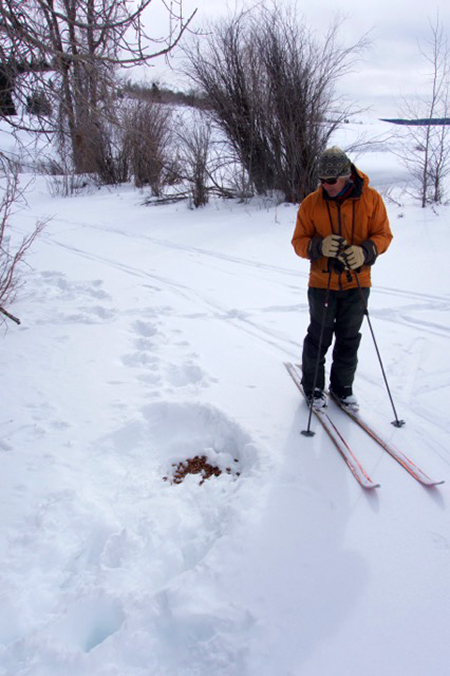
Photo: Beverly Boyton
In their territory around Ditch Creek, Beverly Boynton and Ray White reported Horned Larks, mule deer, Greater Sage-Grouse, and a Great Grey Owl. Kathy McCurdy and Nancy Shea skied the stretch from Kelly to the Gros Ventre Campground and were surprised by an elk in the willows. Marjie Pettus and Brian Bilyeu scouted East Jackson and “did not see a single moose. That said, our trip was not uneventful: we saw elk (of course), bighorn sheep, 2 bald eagles, 3 deer, and no surprise, but fun 2 trumpeter swans” on the National Elk Refuge. Sue and John Ewan were down by the Snake River Sporting Club and spied a large flock of American Robins, along with Townsend’s Solitaires, and a Mourning Dove. Kathy and Jay Buchner also spotted robins north of the junction of Boyles Hill and Ely Springs Roads.
While there were no moose in their territory of the Snake River Ranch, team members observed many tracks and critters. Ben Wise saw “lots of fox tracks, maybe some ermine tracks, and a magnificent pair of bald eagles”. Jennifer Dorsey and KO Strohbehn noted tracks of martin, coyote, fox and deer, and heard Red-winged Blackbirds. Josh Metten, was able to discern “many fox tracks and holes they dug for the ‘catch.’ Vole?” Gretchen Plender reported. “Two Canada Geese flew into land in the ponds on the Shooting Star grounds! Julie (her ski partner) exclaimed, ‘Oh spring is coming!!’”
In addition, Renée Seidler, executive director of JHWF, in the area south of South Park found “two coyotes and a boat-load of swans south of the Snake River.” Mary Ellen and Bill Fausone surveyed Saddle Butte area and reported a fox, 9 deer, and “when we got home a gorgeous Great Horned Owl nesting in a tree. So is was a great day to see wildlife.”
We want to add thanks to the contributions of agencies, wildlife tour companies, and landowners. Sarah Dewey and Carson Butler of Grand Teton National Park found the 4 moose up at Buffalo Valley (fewer than in past years). Sarah also facilitated the park permit. Ben Wise of WGFD organized the team on the Snake River Ranch. Morgan Graham of Teton Conservation District surveyed Game Creek. Note, Morgan used his GIS skills to produce the Moose Day maps when Moose Day first started. Aly Courtemanch is the lead for Moose Day at WGFD. Without her, we would not have Moose Day!
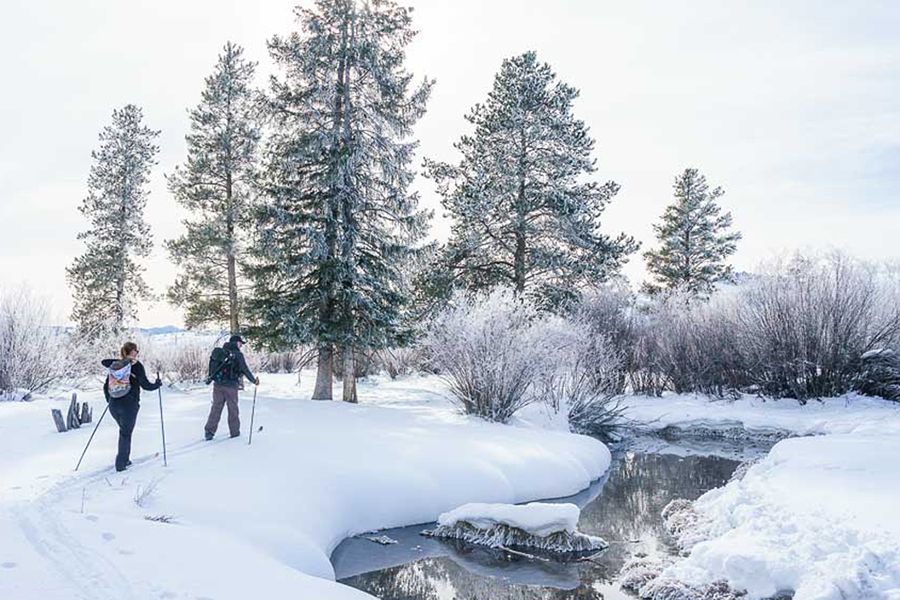
Photo: Josh Metten, Ecotour Adventures
We thank the owners and property managers for permission to scout Snake River Ranch, Spring Creek Ranch, Jackson Hole Winery, Jackson Hole Golf and Tennis, Teton Pines, Astoria Park Conservancy, Snake River Sporting Club, Teton Mountain Schools, and the many other private landowners. We appreciate the volunteer time of tour companies: AJ DeRosa of JH Vintage Adventures, Josh Metten of EcoTour Adventures, and Matt Fagan of Buffalo Roam Tours.
And a final note: We had participation from hearty volunteers of the Barker, Dornan, Craighead, Ewing, and Linn families—who have contributed to the understanding and appreciation of our wildlife heritage over decades. Without their commitment to the valley, we would not have so many moose and other wildlife to enjoy on Moose Day.
This is preliminary data. We will have a final report in our next Nature Mapping enews with a map of where all the moose were and comparisons to years before. However, we wanted you to be the first to know the success of Moose Day 2021.
Thank you all!
Frances Clark,
Volunteer Moose Day Coordinator
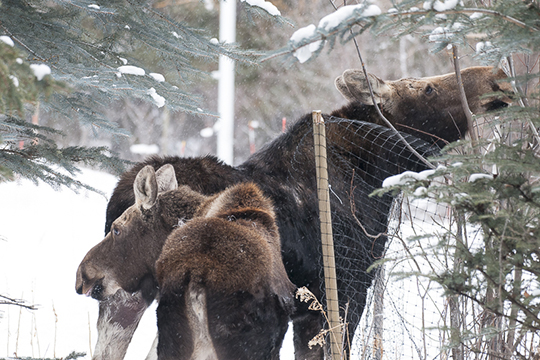
by jhwildlife | Feb 28, 2018 | Blog, Nature Mapping Jackson Hole
by Frances Clark

Two moose for the count by Gigi Halloran
First the stats, then the fun.
We had a windy day with off-and-on light snow, pretty good visibility, and temperature ranging from around 8 degrees to 18 degrees Farenheit in the Jackson area. We had 80 Moose Day volunteers on 33 teams covering 53 different areas. Unfortunately 14 teams struck out…no moose. This is always disappointing to the hardy observers, but “0” is important data, as well. We can get a feel for where the moose don’t go regularly over the years or the variability of their movements.
So where did the moose show up? Wilson once again had a high proportion: about 27 in different clusters and pairs. Grand Teton National Park from Kelly a bit north and west over through the Solitude development had approximately 25. Another eight were seen in the Jackson Hole Golf and Tennis area, including three spotted by Bryan, a guest staying with Randy Reedy. Bryan was getting into his car while Randy was out scouting! Volunteer time: five minutes. Jason Wilmot of USFS and partner saw 15 moose snowmobiling out to the end of the Gros Ventre road. Last year the team saw a remarkable high of 57 moose. Sarah Dewy and Steve Kilpatrick saw five moose in the Buffalo Valley area vs. 20 last year, and an overall low for that territory. The north and southern extremes of our count area had no moose. The total number of moose is 94, but we will double check for a couple of possible overlaps. This number is roughly average–87 is the average count, excluding two high years (2011 – 124 moose; 2017 – 172 moose –both years with alot of snow).
The most observed moose was one browsing and then sleeping along a row of willows just west of Stilson in Wilson. Over eight people reported seeing it there. We will count it once.
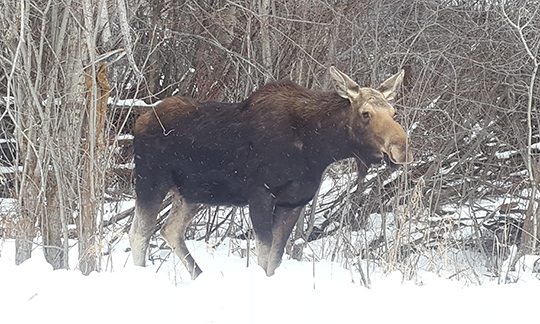
Eight mappers saw this moose, but it was counted once. By Amy Conway.
Other Highlights of the Day Besides Moose:
Several observers saw bald eagles in courtship. Bernie, Diane and Alice saw one pair of adults where the male bird was about 75% smaller than the female–this was an extreme example of a typical size difference in raptors females and males.
That team also sighted Townsend’s Solitaire and Snow Buntings on their territory south of Jackson. Morgan Graham took a picture of a Northern Shrike down in the same vicinity.
Trumpeter Swans, Barrow’s Golden-eyes, Mallards and mergansers were treats along the creeks and rivers.
Two groups of 15-16 elk were seen in different corners of Wilson. Pine Grosbeaks, European Starlings, woodpeckers, Great Blue Herons and coyotes also delighted Nature Mappers, especially those who did not see moose!
Thank you all for keeping your eyes out for moose in Moose Day 2018! The moose thank you, we at Nature Mapping Jackson Hole thank you.
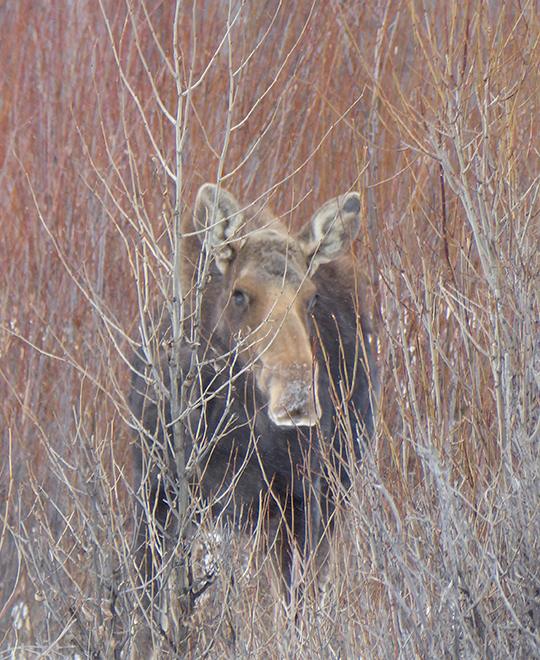
Moose hiding but counted on Moose Day by Kathy McCurdy

by jhwildlife | Mar 7, 2017 | Blog, Nature Mapping Jackson Hole
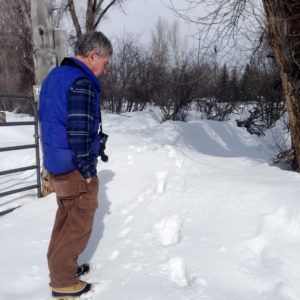
Earle Layser spots moose tracks in West Jackson
Moose Day 2017 set a record for community participation and for the number of moose counted. We extend our thanks to the Nature Mappers and new recruits as well as, biologists from Wyoming Game & Fish Department, Grand Teton National Park and U.S. Forest Service. All volunteered their time from 7 a.m. to 12 noon on Saturday, February 25.
This year, a total of 33 teams, comprising 83 volunteers counted 166 moose, contributing over 290 hours time.
This exceeds our previous record of 124 moose in 2011, and the 99 moose seen last year. Volunteer numbers are well over our 65 person average. In 2016, we had 73 participants helping with the count. This was our 9th annual Moose Day.
Volunteers snowmobiled, snowshoed, drove, walked and most of all, climbed up snow banks to scout moose! Many were rewarded by seeing moose — in some cases many! Successful surveyors often had local tips or tracked fresh moose sign to find hidden individuals. In other cases, neighborhood teams were disappointed to not see the moose that was “there yesterday” and saw no moose at all. However, zero (0) moose is important data as well. And, it is clear that moose move!
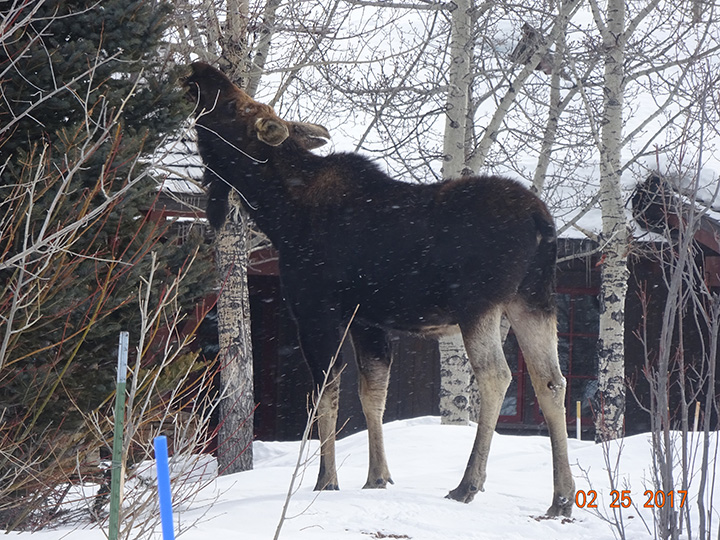
A moose feeding by Randy Reedy
Where were the moose this year? It appears they were attracted to low-lying willow wetlands, such as Buffalo Fork Valley, along the Gros Ventre River and in Wilson. For instance, Kerry Murphy and his U.S. Forest Service team were able to survey the Gros Ventre all the way east to Darwin Ranch. Along this route, often with extensive willow stands, they surveyed 57 moose! Much closer to civilization, moose were seen browsing on exotic shrubs in Jackson or loafing in the shelter of buildings. In a few spots, moose were even congregating close to horses.
Where were moose missing? Often in areas of extremely deep snow, such as the northern stretches of Grand Teton National Park and at the base of the mountains along Fish and Fall Creek Roads. Other wide open areas had little browse for the amount of effort it would take to reach it. Fortunately, most reports indicate moose were in good condition.
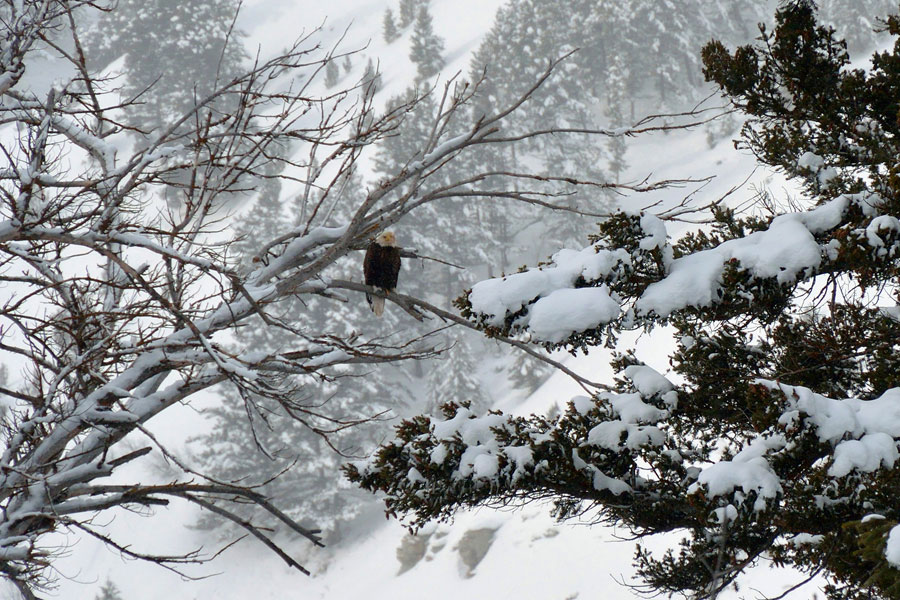
Other critters like Bald Eagles were mapped, too. Photo by Alice Cornell
Whether Nature Mappers saw moose or not, they reported a good time. Many observed (and mapped) other critters as well: wolf, coyote, Trumpeter Swans, otter, beaver, Bald Eagles, elk, Red Crossbills, a dipper and other birds. Teams of friends and strangers enjoyed each other’s company for the morning, and over 30 volunteers showed up at E.Leaven for lunch to share their stories. Moose Day is very much a community event!
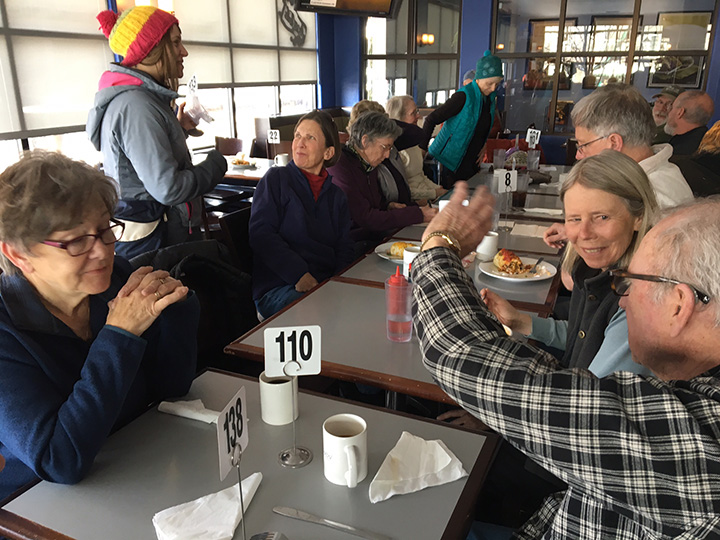
30 moose mappers recounting the morning’s count at E. Leaven. Photo by Frances Clark
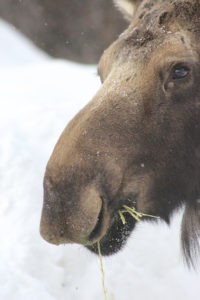
Moose munching by Mary Lohuis
Moose Day is important because we survey moose on private lands, where public-land biologists rarely go. We thank the Snake River Ranch, Snake River Sporting Club, Jackson Holf Golf & Tennis, and Trail Creek Ranch as well as, homeowner associations and individuals for granting permission for us to survey their private property. Without their support we would not have counted so many moose!
Next, Paul Hood and Aly Courtemanch will analyze the data and produce a formal 2017 Moose Day report. This report will enable biologists to determine trends in moose populations and planners to understand where moose roam and rest.
Again, many many thanks to the Nature Mapping Jackson Hole community for caring about our Teton County moose!
Frances Clark
Moose Day Coordinator
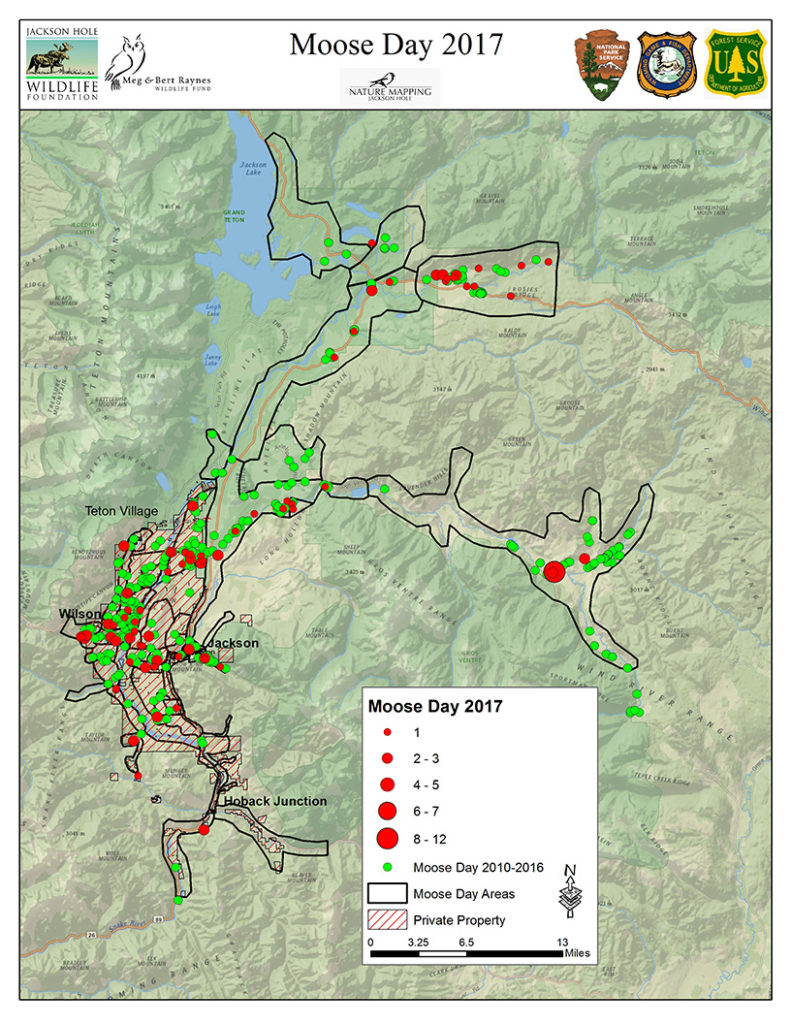
Note: Moose By The River photo by Alice Cornell
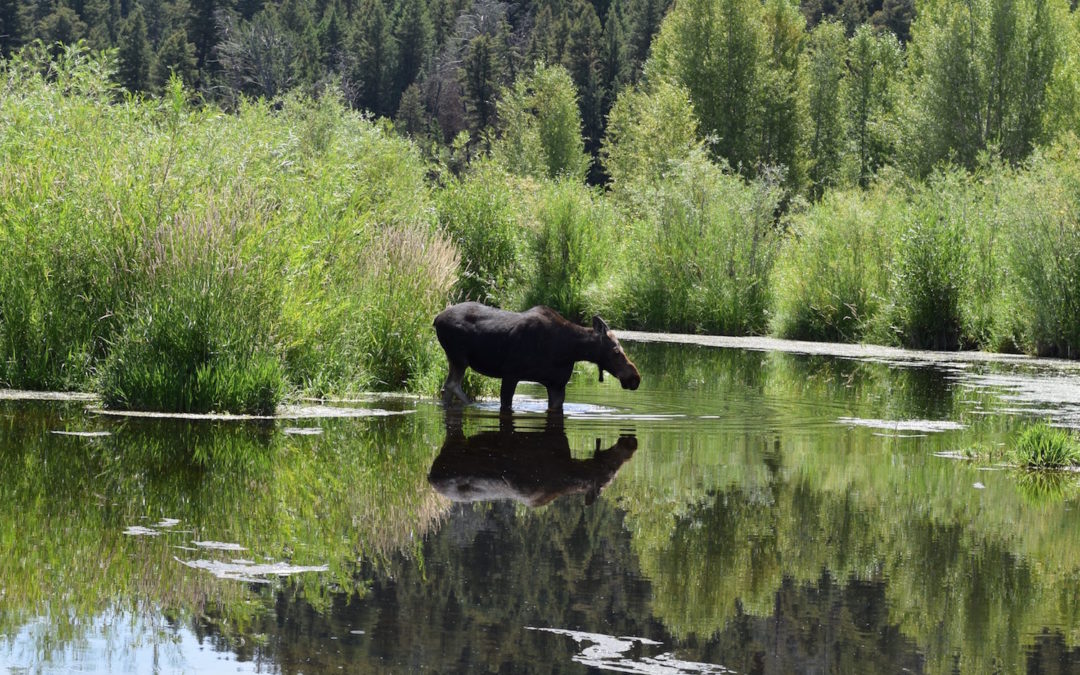
by jhwildlife | Aug 3, 2016 | Blog
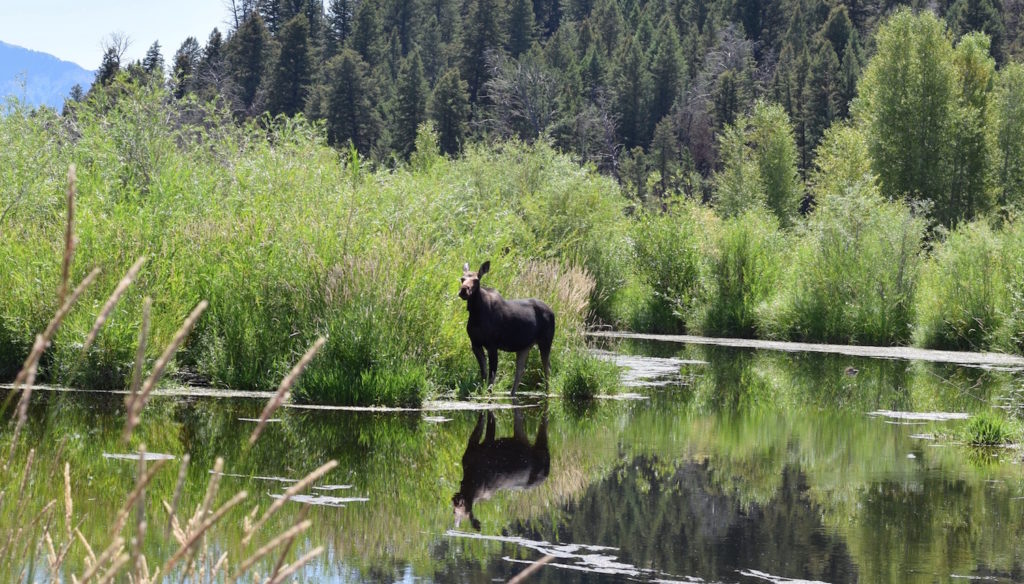
Hello, moose!
There was rustling in the tall grass aside a lazy stream. A Great Blue Heron had led me here, after I had failed in a few attempts to get close to the elegant bird. I had followed its flight from take-off to landing three times now, walking quickly and quietly along the banks of these Snake River backwaters. On this third episode of the chase, the heron swooped low and banked left around some dense vegetation and, for the first time in an hour, left my view. Undeterred, I walked through the brush in the direction of the heron’s flight and zeroed in on its likely landing area. I thought I was close when I saw the rustling of the stream-side grasses. The rustling rose to what sounded like ripping and tearing, and from the vegetation emerged a moose. A clever trick by the heron to lead me to this distraction. My curious, observing eyes had found a new subject. Heron exits stage. Moose steps up to her mark.
Throughout all of this, I hadn’t seen any other people. These side channels are quiet, save for the low hush of the Snake River’s current murmuring beyond. The interactions with wildlife here are intimate. This moose and I were alone in this great theater. I watched her turn her head repeatedly to tear chutes of grass. As the early afternoon sun intensified, she slowly – very slowly – took a step into the water, and then another. And then a long pause as she stood in water that reached nearly to her belly. I could feel her demeanor change as she entered the water – its cooling effect clearly relaxing her and enticing me.
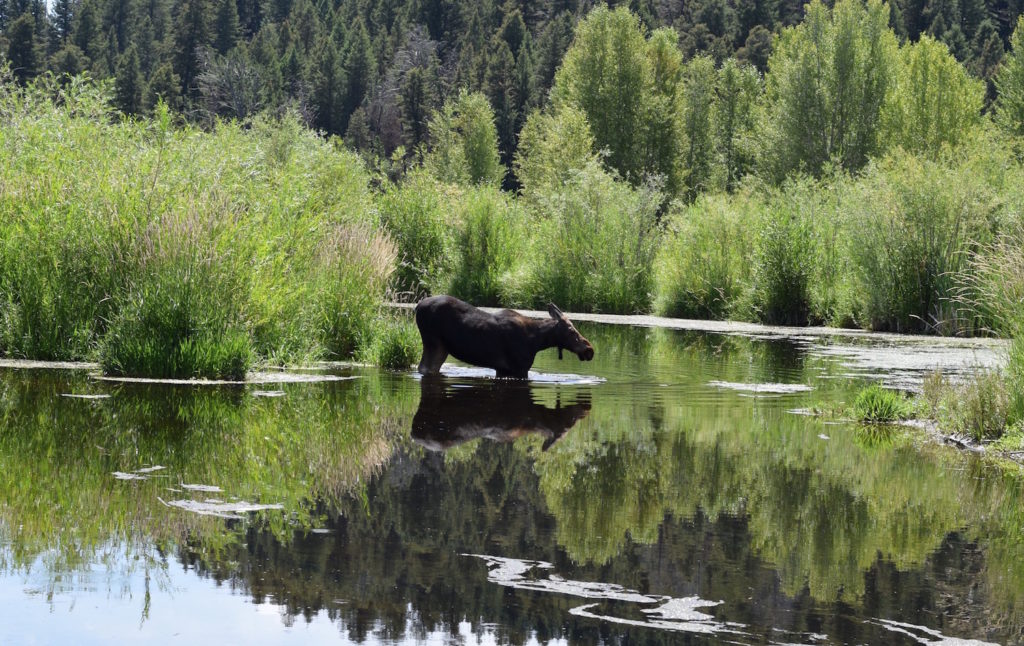
The moose enjoys cooling off on a hot, summer day.
What a joy to observe all of this. After a good while, she moved farther into the backwater and I moved from observation to reflection. What am I learning? What is she sharing with me?
I had come to this place to learn more about birds. I had my bird guide with me and a field notebook. I’ve become familiar with perhaps a few dozen birds by sight and sound this summer, and once that gate was opened, the search has become relentless and exciting. Every day seems to reveal a new bird, and what a gift that is. It’s strange to think that all these birds have always been there, but I never really noticed them.
Before the heron, and long before the moose on this day, I had identified the American Goldfinch for the first time. To those who know this common bird, it’s a fairly ordinary occurrence, however delightful. It’s such an exceptionally beautiful bird to observe. I first saw the goldfinch through my binoculars as it perched in a cottonwood tree. Glancing back and forth between my bird guide and the bird in the tree, I couldn’t identify it with
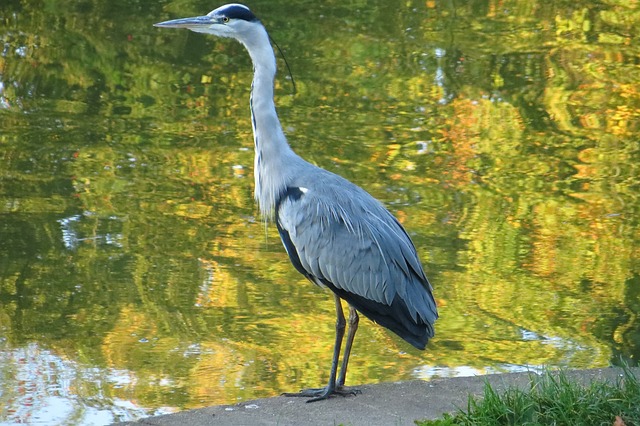
Always a thrill to see the Great Blue Heron.
certainty. But then it flew! And what a distinctive flight it is! Singing as it flies upward, then pinning its wings back for a joyous little dive. Up and down. Up and down, reminiscent of the motion we repeat when we stick our hand outside a car window and ride the air waves. I’ve since been told by an expert birder that the American Goldfinch is the “rollercoaster bird.” Perfect. What an awesome bird!
As this new world of birds has opened to me, so has my desire to record what I observe. I go back to the same place at least weekly – more often if I could – and so far I’ve never failed to see something new. I enter all of my observations into the Nature Mapping Jackson Hole database. By doing so, I contribute to our collective experience of living in this wild place. The data can be useful to local species knowledge and even to planning efforts, but maybe the greater thrill is to feel a part of a community that connects with wildlife in this meaningful way. Once I’ve committed to recording what I observe, the wonderful interactions and beautiful experiences seem to multiply many times. We share with wildlife. We share with each other. This sharing might be the essence of living in this remarkable place.
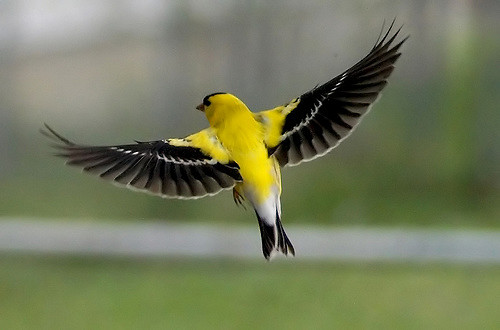
An American Goldfinch in joyful flight. A gift to us!
This valley is filled with some of the world’s finest biologists, birders and experts of every ecological field. While I’m not among these talented folks, my love for wildlife and gratitude for the beauty of a place like Jackson Hole is something that I want to share. Many people feel as I do, and Nature Mapping Jackson Hole is one place where we come together, around a shared appreciation for a place and the wild things we love.
Written by Jon Mobeck, Executive Director of the Jackson Hole Wildlife Foundation, and enthusiastic new Nature Mapper
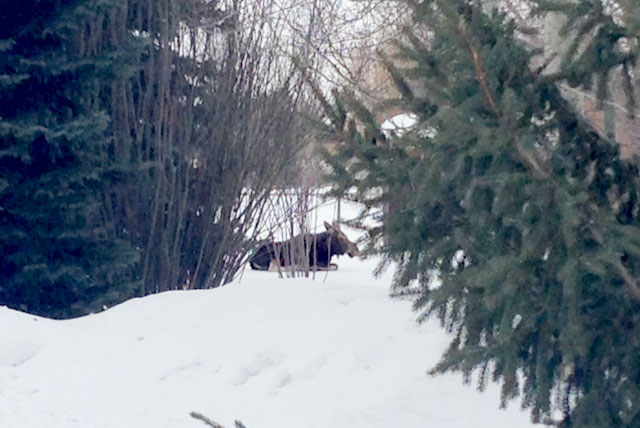
by jhwildlife | Feb 29, 2016 | Blog

Photo by Nature Mapper Kathy McCurdy on Moose Day
Eighth Annual Moose Day Survey Yields Data Similar to 2015
The eighth annual Moose Day Jackson Hole survey was conducted on Saturday, February 27, 2016 from 7:00 a.m. to 1:00 p.m. in collaboration with the Wyoming Game and Fish Department. 73 volunteers from trained Nature Mapping Citizen Scientists, Wyoming Game and Fish Department and Bridger-Teton National Forest personnel took part spending an estimated 223 hours of volunteer time. 99 individual moose were observed in 58 individual search areas.
“Moose Day is such a fun event, bringing people together around the joy of searching for wildlife,” said Jackson Hole Wildlife Foundation Executive Director Jon Mobeck. “It also serves a scientific purpose. The observation data captured on or near participating private ranch lands and residential neighborhoods supplements population surveys conducted by Wyoming Game and Fish, giving us well-rounded information in order to protect moose in the valley.”
During last year’s survey 97 individual moose were observed by 71 volunteers in 61 individual search areas. Moose numbers via this survey remain flat over the past three years.
“Moose Day is truly a community-wide effort: with 73 volunteers searching for moose by ski, foot, car, and snowmobile on a Saturday morning. We have a good time looking, enjoy swapping moose stories, and above all know we are doing something for the moose we all care about. I thank the volunteers and the landowners who are all part of this Citizen Science inventory,” said Frances Clark, coordinator of Moose Day and volunteer coordinator of Nature Mapping Jackson Hole.

